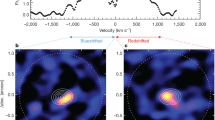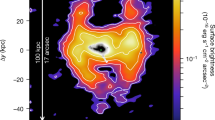Abstract
THE powerful emissions from the nuclei of active galaxies and quasars are thought to arise from the accretion of matter onto a massive black hole. Angular momentum will prevent matter from falling directly onto the central mass; instead, an 'accretion disk' should form, within which the gravitationally bound material will lose angular momentum and gradually spiral inwards. Accretion disks in active galactic nuclei have not hitherto been observed directly, but theoretical models1 suggest that they are comparable in size to the gravitational radius of the central black hole (about 1013 cm) and are heated to high temperatures by the energy released from the accreting matter. Using the Planetary Camera on the Bubble Space Telescope, we have discovered an unexpectedly large (2 x 1020 cm radius) disk of cool dust and gas surrounding a bright unresolved nucleus in theactive galaxy NGC4261. We suggest that the bright point corresponds to thermal emission from the hot disk favoured by theoreticians, and that this is fuelled by material flowing from the cool 'outer' accretion disk. The spin axis of the accretion disk appears to determine the direction of the galaxy's radio jets.
This is a preview of subscription content, access via your institution
Access options
Subscribe to this journal
Receive 51 print issues and online access
$199.00 per year
only $3.90 per issue
Buy this article
- Purchase on Springer Link
- Instant access to full article PDF
Prices may be subject to local taxes which are calculated during checkout
Similar content being viewed by others
References
Rees, M. J. A. Rev. Astr. Astrophys. 22, 471–506 (1984).
Baade, D. & Lucy, L. B. Messenger 61, 24–27 (1990).
Peletier, R. F., Davies, R. L., Illingworth, G. D., Davis, L. E. & Cawson, M. Astr. J. 100, 1091–1142 (1989).
Davies, R. L. & Birkinshaw, M. Astrophys. J. 303, L45–49 (1986).
Jacoby, G. H., Ciardullo, R., Ford, H. C. Astrophys. J. 356, 332–349 (1990).
de Vaucouleurs, G. Astrophys. J. suppl. Series 6, 213–234 (1961).
Binggeli, B., Sandage, A. & Tammann, G. A. Astr. J. 90, 1681–1758 (1985).
Mollenhoff, C., Bender, R. Astr. Astrophys. 174, 63–66 (1987).
Kormendy, J., Stauffer, J. in IAU Symp. No. 127. ‘Structure and Dynamics of Elliptical Galaxies’ (ed. de Zeeuw, P. T.) 405–406 (Reidel, Dordrecht, 1987).
Birkinshaw, M. & Davies, R. C. Astrophys. J. 291, 32–44 (1985).
Pringle, J. E. A. Rev. Astr. Astrophys. 19, 137–162 (1981).
Israel, F. P. et al. Astr. Astrophys. 227, 342–350 (1990).
Bertola, F. in IAU Symp. No. 127, ‘Structure and Dynamics of Elliptical Galaxies’ (ed. de Zeeuw P. T.) 135–143 (Reidel, Dordrecht, 1987).
Author information
Authors and Affiliations
Rights and permissions
About this article
Cite this article
Jaffe, W., Ford, H., Ferrarese, L. et al. A large nuclear accretion disk in the active galaxy NGC4261. Nature 364, 213–215 (1993). https://doi.org/10.1038/364213a0
Received:
Accepted:
Issue Date:
DOI: https://doi.org/10.1038/364213a0
This article is cited by
-
Supermassive Black Holes in Galactic Nuclei: Past, Present and Future Research
Space Science Reviews (2005)
Comments
By submitting a comment you agree to abide by our Terms and Community Guidelines. If you find something abusive or that does not comply with our terms or guidelines please flag it as inappropriate.



